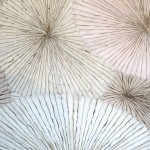Within the context of Korean artist Minjung Kim’s upcoming solo exhibition in Venice during Venice Art Biennale 2015, we filmed a conversation between the artist and the art historian and curator Jean-Christophe Ammann. In this conversation, Minjung Kim and Jean-Christophe Ammann talk about Minjung Kim’s work and biography, as well as about the current art market and art criticism. The video above is an excerpt, please scroll down for the complete video.
Minjung Kim’s solo exhibition in Venice, Italy, presented by Luxembourg & Dayan Gallery (New York), is entitled The Light, The Shade, The Depth. The show at Ca’boto, Via Garibaldi 1643 at Riva dei Steet Martiri, Venezia, is curated by Jean-Christophe Ammann and runs from May 5 until September 27, 2015. It’s a survey exhibition of the Korean artist’s works made over the last fifteen years.
Artist Minjung Kim in Conversation with Jean-Christophe Ammann, Frankfurt am Main (Germany), March 20, 2015.
> Right-click (Mac: ctrl-click) this link to download Quicktime video file.
Complete video (44:38 min.):
https://vimeo.com/123830345
The Swiss art historian and curator Jean-Christophe Ammann was born in 1939 in Berlin. He grew up in Fribourg, Switzerland. Ammann studied art history, Christian Archaeology and German literature at the University of Fribourg. In 1966 he received his PhD on the work of Louis Moilliet. From 1967 to 1968 he worked with Harald Szeemann at the Kunsthalle Bern. Afterwards, he was director of Kunstmuseum Luzern. In 1971, he was Swiss commissioner for the Paris Biennale. In 1972, he worked with Harald Szeemann on documenta 5. In 1978 he was co-organizer of the Arte Nature in the International Pavilion at the Venice Biennale. Ammann was director of Kunsthalle Basel from 1978 to 1988. Since 1981 he has been a member of the Emanuel Hoffmann Foundation in Basel. From 1991 to 2001 he was director of the Museum of Modern Art, MMK, in Frankfurt.
Biographical information from Minjung Kim’s website:
Minjung Kim was born in Gwangju in the Republic of Korea in 1962. From the age of six, it was her family’s wish that she study painting under various teachers, including the famous watercolourist Yeongyun Kang, and, between the ages of thirteen and twenty-nine, Oriental calligraphy. This latter study allowed her to understand the fundamental precepts of Asiatic speculative tradition. As Giangiorgio Pasqualotto describes in an illuminating essay, the peculiarity of Oriental writing “lies in the fact that is able to design not just the structure of each object, but also, and above all, the action, the active power and the efficacy that the object, whether material or conceptual, contains and expounds. This capacity to make visible the activity or efficacy of an objects is in perfect harmony with the way earliest Chinese culture – classical Tao – understood the universe, as it had always considered everything that is real, not as a set of objects, but as an infinite universe of processes: on the basis of this conception of the world, everything, including apparently inert objects, is invested with an active power, an energy that is not secondary to its existence” (G. Pasqualotto, La via della scrittura, 1992). The study of calligraphy did not just endow Minjung with this vision of the world but also taught her to communicate by means of the extremely controlled use of the brush, which “channels” the energy and directs it onto the paper. When in 1980 she enrolled in the Hong Ik university in Seoul, Minjung had already received a very thorough artistic education which was completed trough the detailed study of Oriental painting. Once her university course had been completed in 1985, she took a Master’s degree at the same university with a thesis on the four basic material in ink painting (rice paper, brush, ink pigment and the pigment grinding stone).
In 1991 she decided to move to Italy and enrol at the Brera Academy in Milan. Here she studied less the basic of European painting, which she had already tackled at university in Korea, than the analysis of the works of Western artists who, during the 20th century, studied Oriental painting. In particular, certain works by Paul Klee and Franz Kline prompted her to approach a new aesthetic direction that look her progressively away from the figurative tradition of her country of origin towards an investigation of the expressive value of marks and maculas, two stylistic elements that combine perfectly with the “process-based view of the world” and the ability to “channel the energy”, both o which she learned in her study of calligraphy. Her exploration of the interrelationship between Oriental and Western techniques and conceptions continues outside the Academy. She always executes her pictorial work on the floor, in keeping with Oriental tradition, because both literally and metaphorically the floor is the basic support for all painting. In her works, since 1998 on overlaid layers of paper, she burnt sections of them to generate an effect of three-dimensionality, to provide the viewer with a chronological dimension, and to indicate layers of time symbolised by the layers of paper. She gives quivering condition that is created by the burnt edges, and that reveals the form as they flourish, change, are overshadowed and then re-emerge from the background, immersed in those resounding spaces that embraces, contains and connects them all.
This is the key to the great charm of Kim Minjung’s work: a devotion to art that transcends itself in a profound contact with life, expression of a innate beauty and ungraspable amazement at incompleteness, at feeling oneself perennially among things.
Minjung currently lives and works in South of France and United States.
She exhibited in important museums (Fondazione Palazzo Bricherasio, Torino; Museo comunale, Ascona; Museum Sbygningen, Copenhagen, Henry Moore Institut, Leed; Guanshan Yue art Museum, Shenzhen; Macro – Museo arte contemporanea Roma) and her works are in important private collections.




